#Hamilton Wood Type Museum
Text
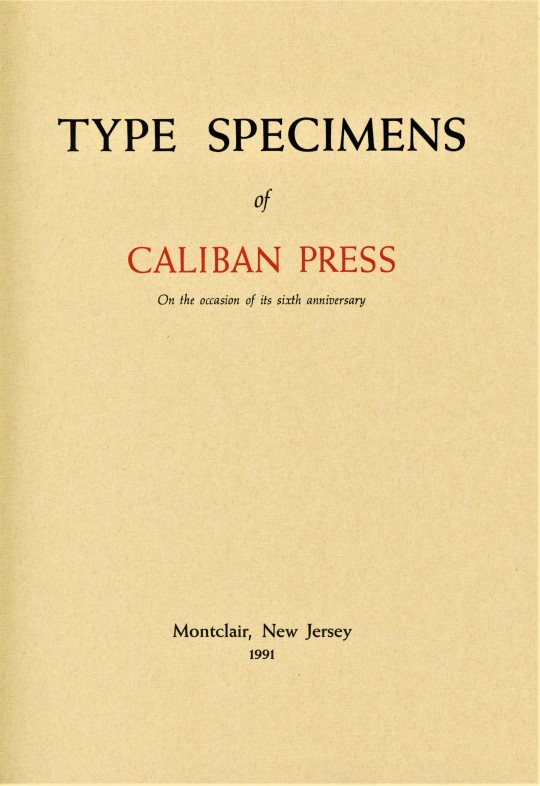
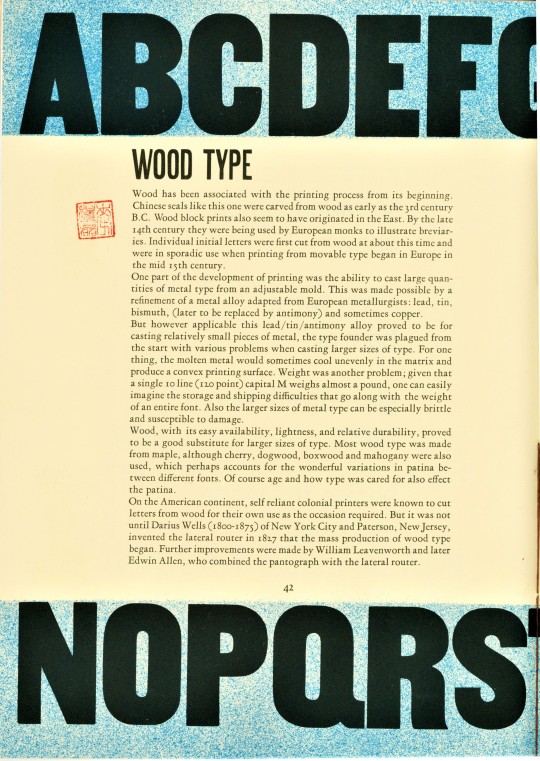
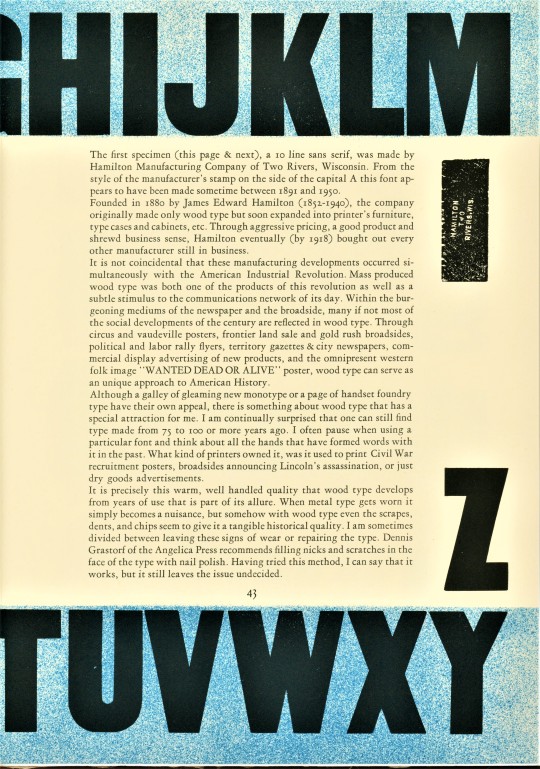
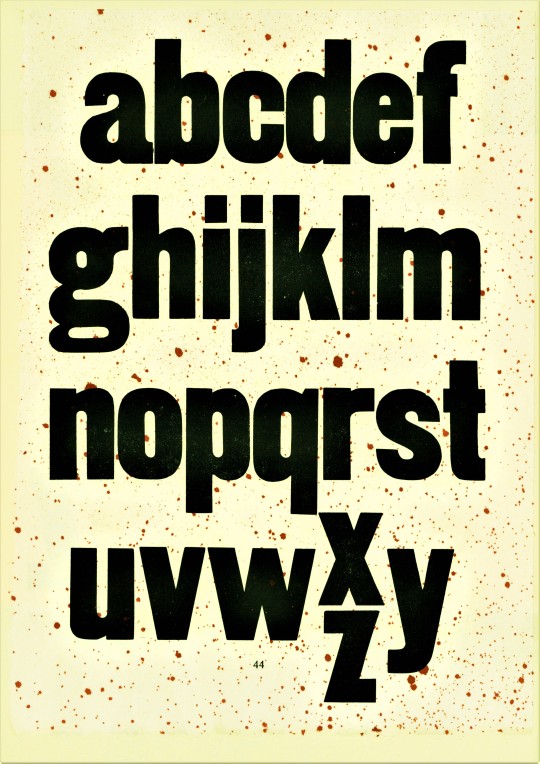
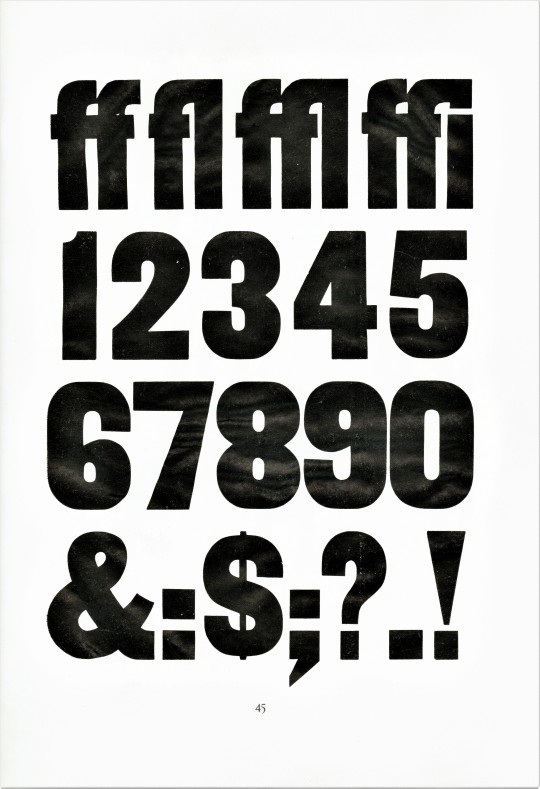

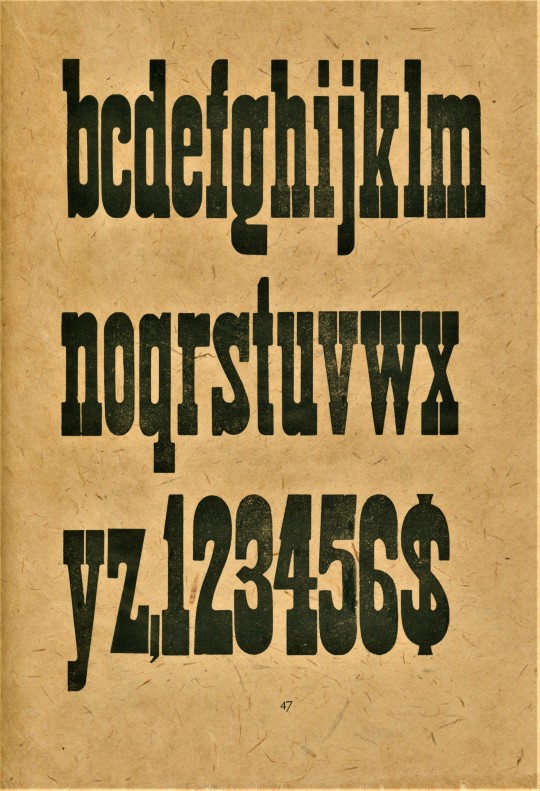

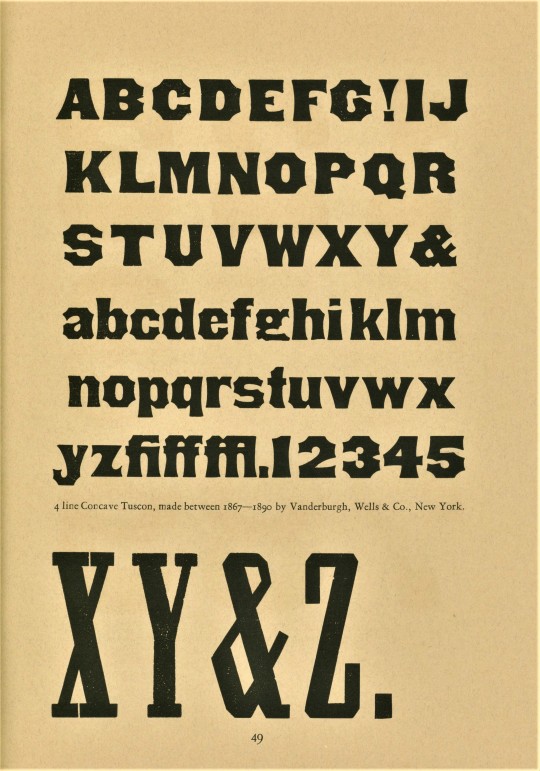
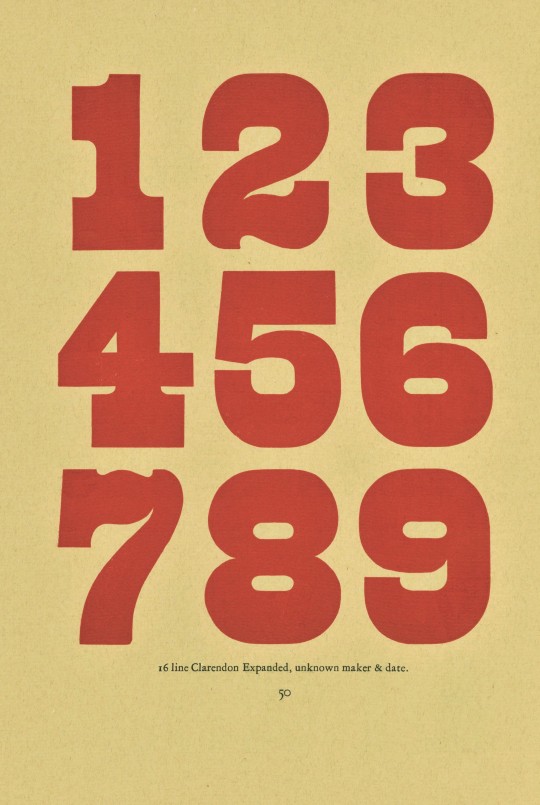

Typography Tuesday
As some of our longtime followers probably know, we adore wood type. So, this week we present some wood type samples from Type Specimens of Caliban Press On the occasion of its sixth anniversary, from the recent donation of the estate of our late friend, art professor, painter, collector, letterpress printer, and book artist Dennis Bayuzick. The publication was letterpress printed and hand-bound by special collections librarian and fine press printer Mark McMurray in 1991 at his Caliban Press in Montclair, New Jersey, in an edition of 100 copies signed by the printer.
The first few unidentified specimens on pages 42 to 45 were made by the Hamilton Manufacturing Company, right here in Two Rivers, Wisconsin, which for almost a century was the largest producer of wood type in the world. The company stopped producing wood type in the 1980s, but continued to produce other manufactured goods, and finally left Two Rivers in 2013. Its wood type legacy lives on, however, in Two River's magnificent Hamilton Wood Type & Printing Museum, an essential pilgrimage site for any lover of wood type!
View other posts with wood type.
View more posts related to the Hamilton Wood Type & Printing Museum.
View more Typography Tuesday posts.
#Typography Tuesday#typetuesday#wood type#Caliban Press#Type Specimens of Caliban Press#type display books#type specimens#specimen books#Mark McMurray#letterpress printing#fine press books#Hamilton Wood Type & Printing Museum#Hamilton Wood Type Museum#Hamilton wood type#Hamilton Manufacturing Company#Dennis Bayuzick
22 notes
·
View notes
Video
TR Teen at the Musuem by Lester Public Library
Via Flickr:
An awesome class at the awesome Hamilton Wood Type and Printing Museum! Make prints with tree cookies (cross sections of tree trunks that indicate how trees grow). Note that teens must register and obtain permission slips IN ADVANCE here at the Lester Public Library, Two Rivers, Wisconsin.
#Hamilton Wood Type & Printing Museum#Hamilton#museum#365LIBS#Lester Public LIbrary#libraries and librarians#LPL#Library#Lester Public Library#Two Rivers#WIsconsin#Libraries#libs&libs#Wisconsin#TrueToTwo#Explore Two Rivers#teens#teens@LPL#teens in your library#teen#teenprograms#teen late night#Youth Programming#Youth Programs#Youth Program#youth services#Wisconsin Libraries#Read#Discover#Connect
2 notes
·
View notes
Text

OOPS!
If you don't make mistakes, you're not working hard enough!
Increase experience! Make more mistakes quicker!
0 notes
Text
A couple of weeks ago I asked about people’s favorite book or books they read this year. Between Facebook, Instagram, Twitter, and discord, I have a list of 123 books in no particular order that my friends and family loved this year. If it was a series then I listed the first book. Each star is an additional recommendation. I haven’t read all of these, they may or may not reflect my personal opinions, though my favorite books are on the list too. The most recommended books were How Far The Light Reaches by Sabrina Imbler, one or all of the Murderbot books by Martha Wells, and Light from Uncommon Stars by Ryka Aoki, because if there’s one thing my friends have in common across platforms, it’s that you’re all nerds (affectionate). Enjoy, and I hope you find your new favorite book!
Reformatory by Tananarive Due
Not My Father’s Son by Alan Cumming
Jesus and John Wayne by Kristen Kobes de Mez
The Soul Of An Octopus by Sy Montgomery
Rough Sleepers by Tracy Kidder
The Going To Bed Book by Sandra Boynton
My Hijacking by Martha Hodes
Longhand by Andy Hamilton
Babel by RF Kuang*
The Vaster Wilds by Lauren Groff*
Lies We Sing To The Sea by Sarah Underwood
The Remarkable Journey of Coyote Sunrise by Dan Gemeinhart
Dress Coded by Carrie Firestone
I Lost My Tooth! by Mo Willems
The Fourth Wing by Rebecca Yarros
Spirits Abroad by Zen Cho
How Far The Light Reaches by Sabrina Imbler**
Radiant Fugitives by Nawaaz Ahmed
Solito: A Memoir by Javier Zamora
The Making of Another Motion Picture Masterpiece by Tom Hanks
These Precious Days by Ann Patchett*
I’m Stuck by Julia Mills
Entangled Life by Martin Sheldrake
Iris by Eden Finley
Hot Vampire Next Door by Nikki St. Crowe
Devil of Dublin by BB Easton
Tied by Carian Cole
Romantic Comedy by Curtis Sittenfeld*
Fangirl by Rainbow Rowell
From Blood And Ash by Jennifer L. Armentrout
Where I End by Sophie White
Wool by Hugh Howey
The Six Deaths of the Saint by Alix E. Harrow
Yellowface by RF Kuang
Idlewild by James Frankie Thomas
North Woods by Daniel Mason
After Sappho by Selby Wynn Schwartz
Tomorrow and Tomorrow and Tomorrow by Gabrielle Zevin*
The Fragile Threads of Power by VE Schwab
My Heart is a Chainsaw by Stephen Graham Jones
Sapiens by Yuval Noah Harari
The New Jim Crow by Michelle Alexander
The Book of the Unnamed Midwife by Meg Elison
Call Your Daughter Home by Deb Spera
The English Understand Wool by Helen Dewitt
Preserving Food Without Freezing or Canning by The Gardeners & Farmers of Terre Vivante
How Not to Drown in a Glass of Water by Angie Cruz
Blood Like Magic by Liselle Sambury
Firekeeper’s Daughter by Angeline Boulley
Love In The Time of Serial Killers by Alicia Thompson
Imogen, Obviously by Becky Albertalli
The Wicked Bargain by Gabe Cole Novoa*
Camp Damascus by Chuck Tingle
Welcome to Night Vale by Jeffrey Cranor and Joseph Fink
The Sunbearer Trials by Aiden Thomas
The Last Mapmaker by Christina Soontornvat
Funny You Should Ask by Elissa Sussman
Gideon The Ninth by Tamsyn Muir
Prophet by Sin Blache and Helen MacDonald*
Light From Uncommon Stars by Ryka Aoki**
System Collapse by Martha Wells***
The Brutish Museums by Dan Hicks
A Memory Called Empire by Arkady Martine*
A Desolation Called Peace by Arkady Martine
A Psalm For The Wild Built by Becky Chambers*
Several People Are Typing by Calvin Kasulke
The Lazarus Heist by Geoff White
The September House by Carissa Orlando*
I’m Glad My Mom Died by Jennette McCurdy
Iron Widow by Xiran Jay Zhao
The Spirit Bares Its Teeth by Andrew Joseph White
Mistletoe and Mishigas by MA Wardell
A Restless Truth by Freya Marske
The Last Smile In Sunder City by Luke Arnold
The Hidden Case of Ewan Forbes by Zoe Playden
The Song of Achilles by Madeline Miller
Manywhere by Morgan Thomas
Shit Cassandra Saw by Gwen E. Kirby
Loot by Tania James
The Art Thief by Michael Finkel
Grave Expectations by Alice Bell
Astrid Parker Doesn’t Fail by Ashley Herring Blake
A Marvellous Light by Freya Marske
Kiss Her Once For Me by Alison Cochrun
The Goblin Emperor by Katherine Addison
All Systems Read by Martha Wells
The Once and Future Sex by Eleanor Janega
Mort by Terry Pratchett
Into The Drowning Deep by Mira Grant
Station Eleven by Emily St. John Mandel
Crying in H Mart by Michelle Zauner*
The Door by Magda Szabo
Fluids by May Leitz
The Readers of Broken Wheel Recommend by Katarina Bivald
Nona the Ninth by Tamsyn Muir
Lieut. John Irving, R.N. of H.M.S. "Terror" in Sir John Franklin's last expedition to the Arctic regions a memorial sketch with letters
In Five Years by Rebecca Serle
Raven the Pirate Princess by Jeremy Whitley
Under the Whispering Door by TJ Klune
The Fiancée Farce by Alexandria Bellefleur
Assassin's Apprentice by Robin Hobb
Slewfoot by Brom
The Secret Life of Groceries by Benjamin Lorr
500 Miles From You by Jenny Colgan
O Caledonia by Elspeth Barker
The Hand That First Held Mine by Maggie O’Farrell
The Secret Lives of Country Gentleman by KJ Charles
A Line In The World by Dorthe Nors
The Starless Sea by Erin Morgenstern
Glitter and Concrete by Elyssa Maxx Goodman
The Spear Cuts Through Water by Simon Jimenez
Tender Is The Flesh by Agustina Bazterrica
The Tragic Menagerie by Lydia Zinovieva-Annibal (translated by Jane Costlow)
The 100 Years Of Lenni and Margot by Marianne Cronin
Beartown by Fredrik Backman
I Have Some Questions For You by Rebecca Makkai
Demon Copperhead by Barbara Kingsolver
Tom Lake by Ann Patchett
Starling House by Alix E. Harrow
Twisted Love by Ana Huang
Precise Oaths by Paige E. Ewing
Hench by Natalie Zina Walschots
A Dead Djinn In Cairo by P. Djeli Clark
#favorite books#favorite books of 2023#books#books and reading#what we read this year other than fanfic
6 notes
·
View notes
Photo
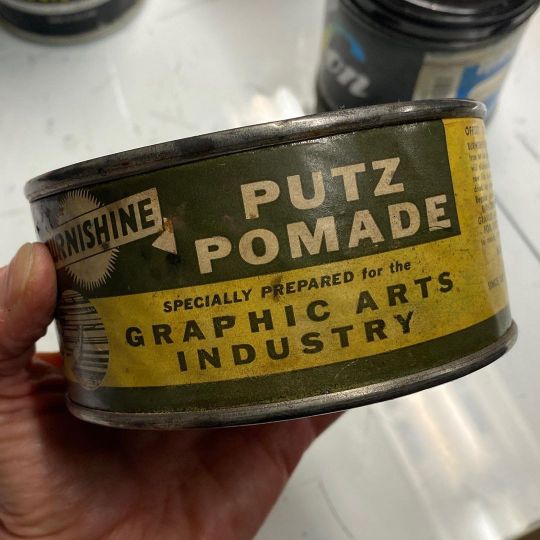
For @pipletterpress Shop Talkers: had to shsre this super vintage Putz Pomade can from @hamiltonwoodtype which brings me joy (and pumice). May your rollers be glaze free! #letterpress #putzpomade (at Hamilton Wood Type & Printing Museum) https://www.instagram.com/p/CenDPG-OYi6/?igshid=NGJjMDIxMWI=
5 notes
·
View notes
Text

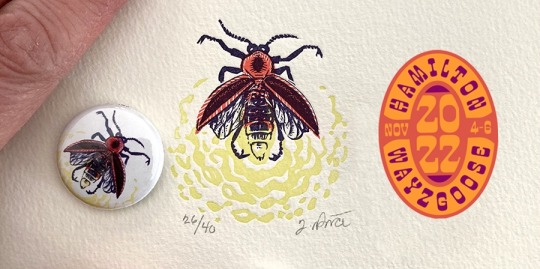
Fancy a pre-conference workshop at Hamilton Wood Type & Printing Museum's Wayzgoose? Join me on Friday November 4 for “Wood Engraving: Devilishly Detailed Letterpress Initials”. Wayzgoosers will also get a reproduction of my Firefly engraving on a 1" button! Hope to see you there!
Register: https://woodtype.org/pages/wayzgoose
#seed #woodengraving #letterpress #initials #workshop
4 notes
·
View notes
Text

Photo by Hubert R. Wentorf, ca. 1895, of Hamilton Manufacturing Company, original building known as "A" and office.
Present in photo are H.P. Hamilton, standing in the doorway at center of picture, Arthur Lohman, standing in office doorway, and employees, recognized from right to left, Joseph Stodola, Andrew Bishop, Mike Knipfer, Charles Rippel, Nic Moseler, unknown, unknown, Nic Moseler, Hans Honeckson, Frank Kaufman, Charles Hansen, John Smith, unknown, Mr. Cady, Mike Schippert, unknown, unknown, Henry Kurtz, John Goldammer, unknown, John Weilep, Peter Feurstein, unknown, Charles Wacholtz, unknown, unknown, unknown, unknown, unknown, unknown, Albert Simonis, unknown, unknown, unknown.
C/o University of Wisconsin-Madison Libraries and via Hamilton Wood Type & Printing Museum.
0 notes
Text

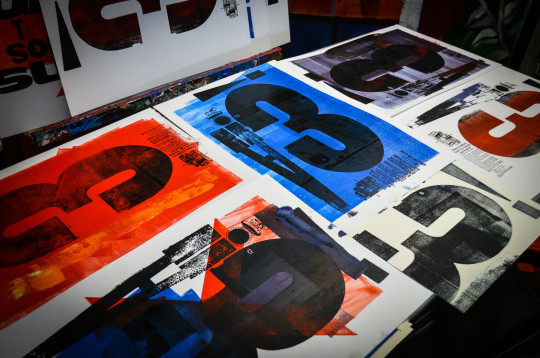

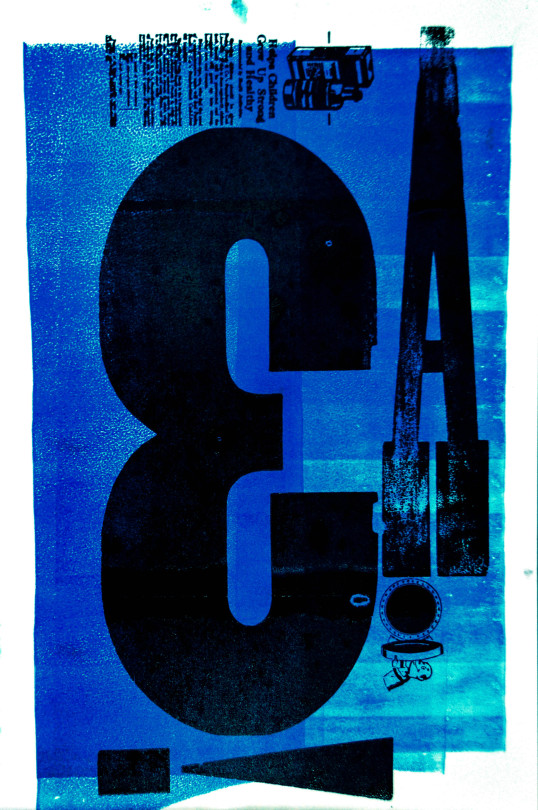

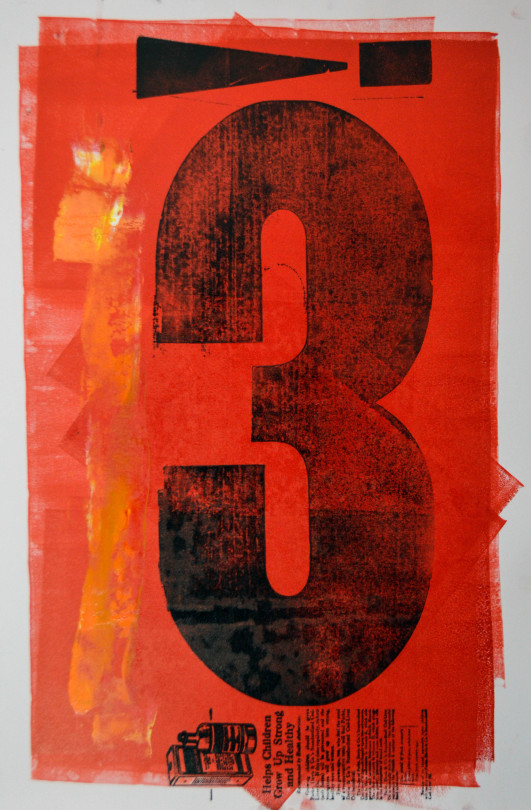
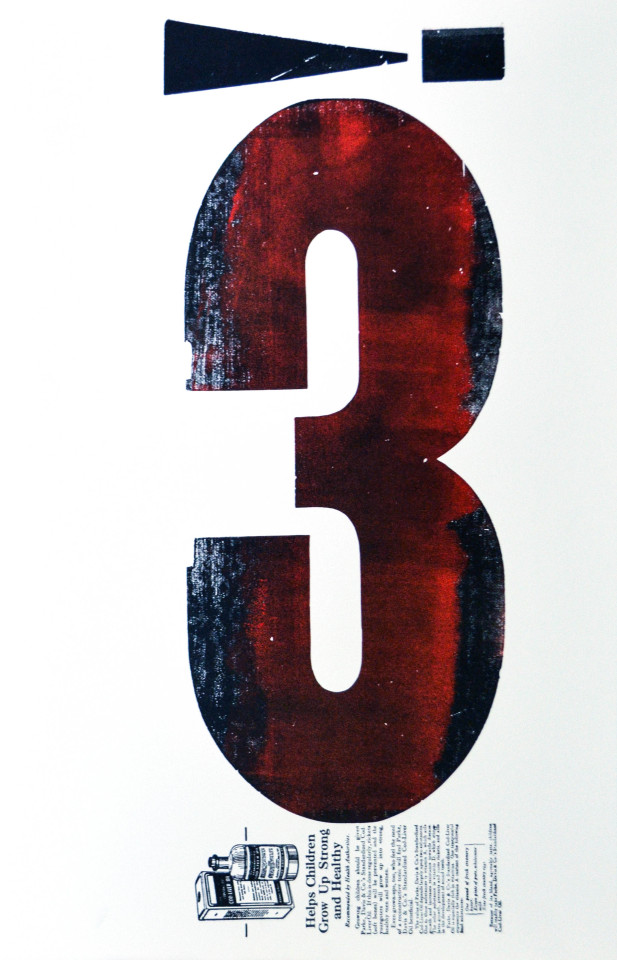

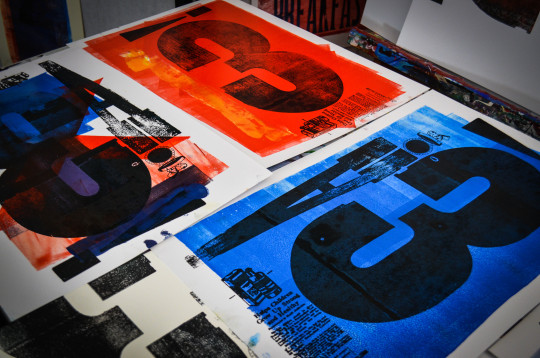

3!A
Fun with Prints at the Hamilton Wood Type Museum in Two Rivers Wisconsin. What a wonderful place.
Various wood-block prints.
14x19"
Ink on paper
#wood block printing#art#milwaukee#fine art#painting#fleming#symbol#symbolism#figure#acrylic#figurative#ink#printmaking#print#on paper#hamilton wood type museum#antiques#wood block#typography
3 notes
·
View notes
Text
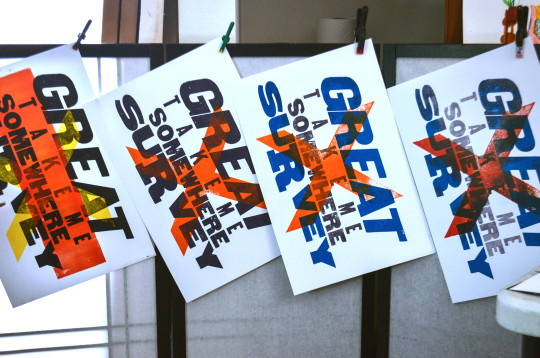
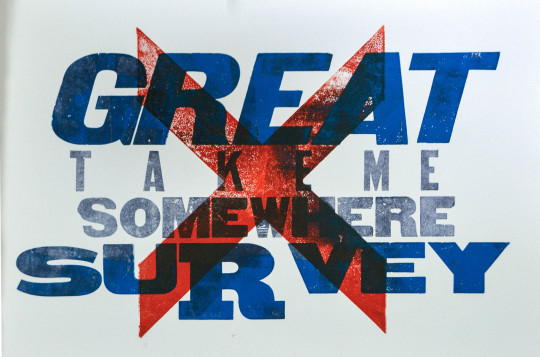

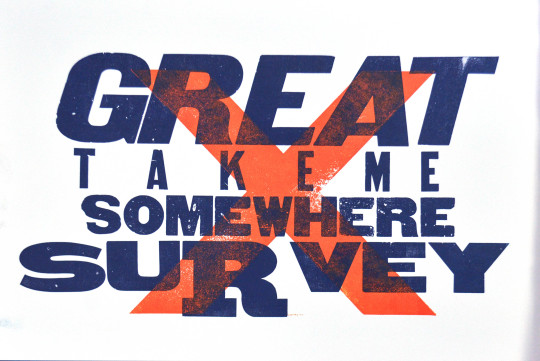
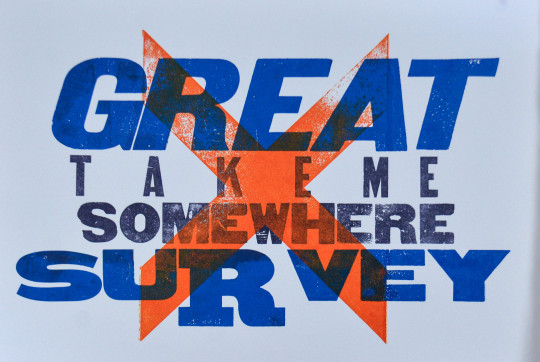
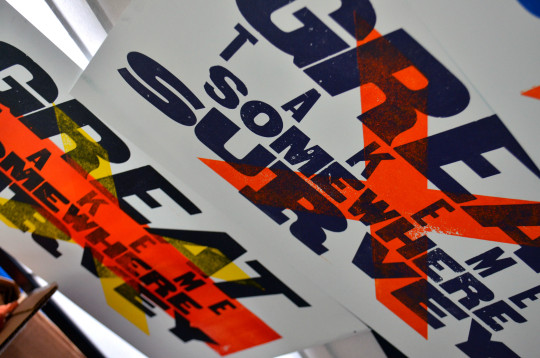
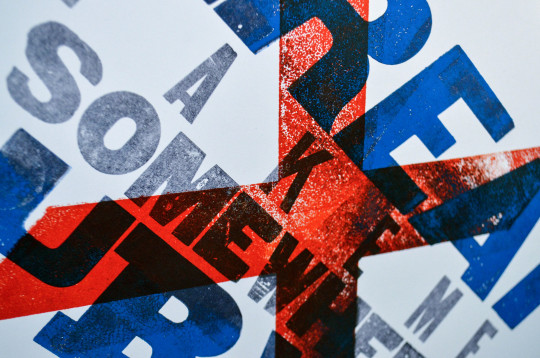
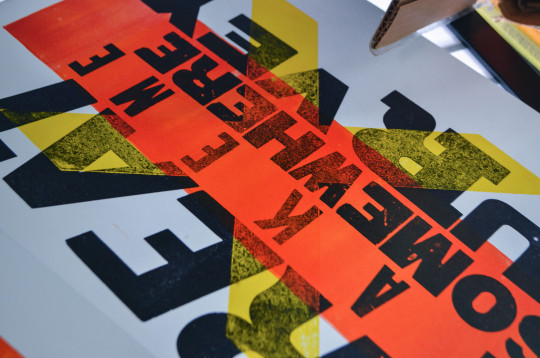
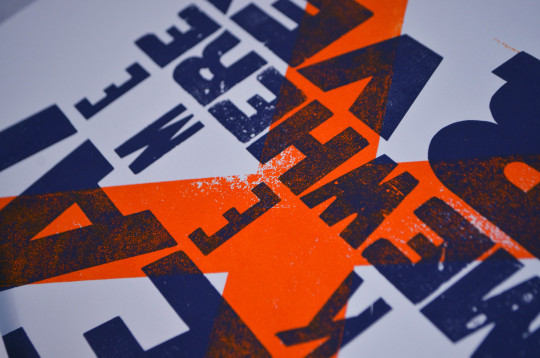
Fun with printmaking.
#great survey#graphic novel#typography#wood type#hamilton wood type museum#printmaking#print#printing#on paper#layer#ink#wisconsin history
1 note
·
View note
Photo

Join us for a virtual tour of Luce Visible Storage, one of the gems of the Luce Center for American Art! While only a fraction of the Brooklyn Museum’s holdings are on view in the galleries, Luce Visible Storage gives open access to some 2,000 works in storage for visitors, scholars, and students to view and research. Let’s take a look at some of the collections.
Created by Jane Dini, Andrew W. Mellon Senior Curator, American Art, Catherine Futter, Senior Curator, Decorative Arts, Margarita Karasoulas, Assistant Curator, American Art, Nancy Rosoff, Andrew W. Mellon Senior Curator, Arts of the Americas, and Elizabeth St. George, Assistant Curator, Decorative Arts.
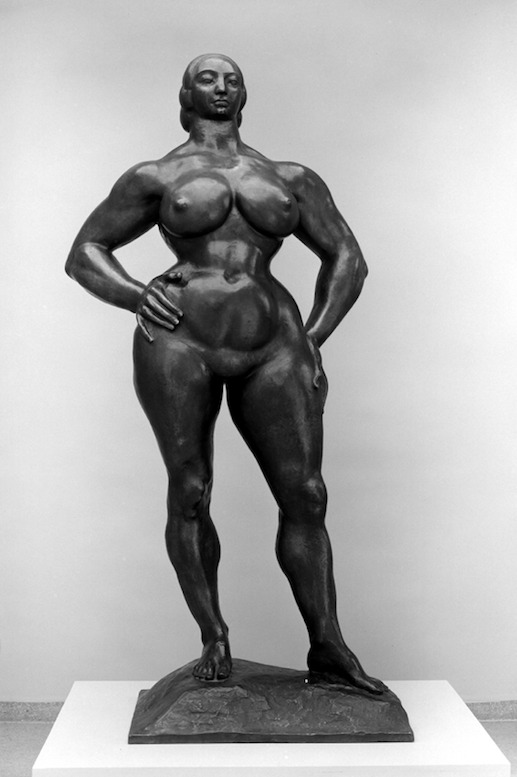
Gaston Lachaise’s monumental Standing Woman is among one of the larger-than-life-size sculptures visitors encounter in Luce Visible Storage.
The pronounced contrapposto of the figure’s pose evokes classical traditions, while the robust proportions and sensuous treatment of the female form recall Paleolithic fertility figures. This sculpture is a pictorial homage to the artist’s model and muse (and later wife) Isabel Nagel, who inspired numerous other works.

The Brooklyn Museum’s collection is particularly strong in direct carving, where sculptors carved directly on the chosen material, whether wood or stone, and advocated “truth to materials.” Many of these modernist artists were recent immigrants to the United States.

The French-born sculptor Robert Laurent studied under the painter Hamilton Easter Field in Brooklyn Heights. Carved out of alabaster and weighing nearly two hundred pounds, Robert Laurent’s The Bather depicts an idealized, nude female figure in a dynamic pose, her finely carved hair cascading over her body. Laurent preferred working with this material, noting that “…the beauty of alabaster is its transparency. This is what gives it life and vibration.”
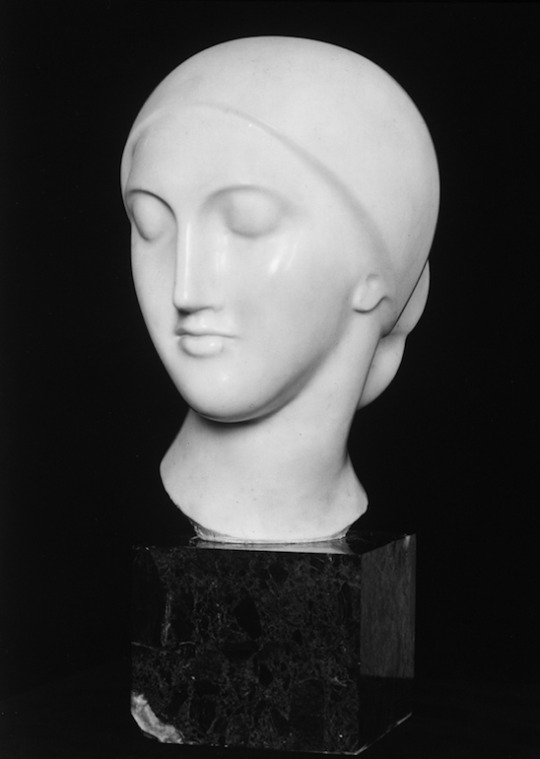
Upon moving to New York City in 1914, Polish-born sculptor Elie Nadelman earned acclaim for his early idealized and classical heads such as La Mysterieuse. Here, rhythmic, curvilinear shapes imbue the sculpture with a sense of dynamism. As Nadelman once acknowledged, “I employ no other line than the curve.”
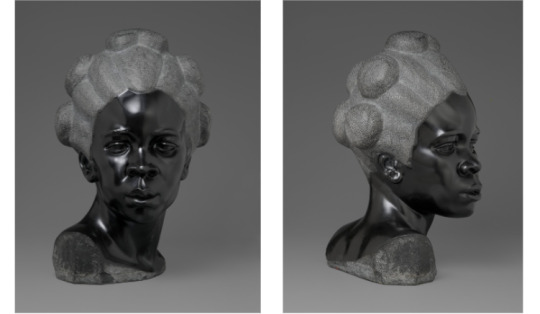
A protégé of French sculptor Auguste Rodin, Malvina Hoffmann was one of the foremost women artists of the twentieth century. Inspired by her travels in North Africa in the late 1920s, Martinique Woman (1928) anticipates Hoffmann’s later work on The Races of Mankind for the Field Museum. Although the work represents a racial type, its modernized realism signals a deliberate break with earlier treatments of African subjects ranging from caricature to romanticism.

This screen features the museum’s important collection of early twentieth century modernism, including, in the bottom-right corner, Marsden Hartley's Handsome Drinks from 1915.
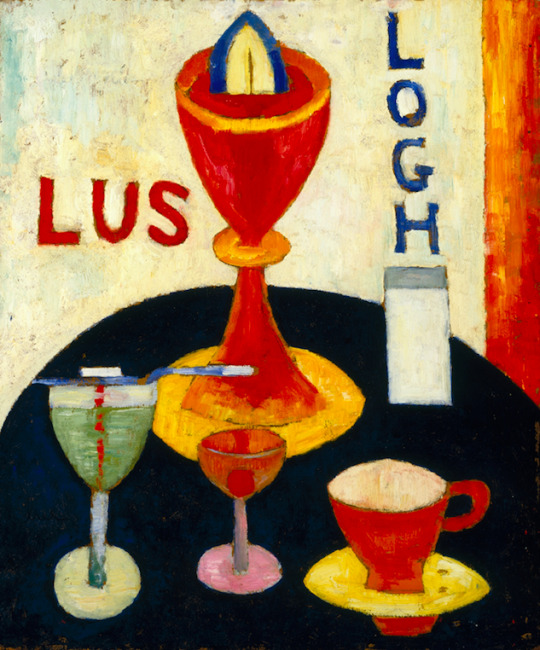
Responding to the 1915 downing of the RMS Lusitania (or LUS) by a German U-boat off the coast of Ireland, Hartley implores the countries united in response—the United States represented as a Manhattan cocktail flanked by France as a glass of absinthe and the United Kingdom as a cup of tea, to “Forgive (or LOGH in Irish) the blockhead,” or boche an offensive term for a German soldier. The flaming chalice underscores this plea for unity and peace a year before the United States officially entered into the First World War.

In addition to sculpture and painting, decorative arts also abound in Luce Visible Storage.
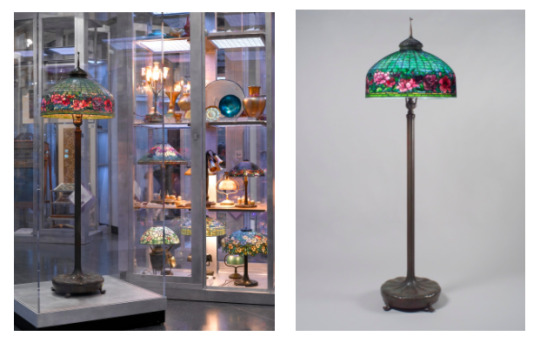
The museum has a large collection of objects made by Tiffany Studios (formerly in Corona, Queens) including this lamp with delicately cut shades of glass in green, pink, and purple. Each Tiffany lamp has an original composition, many designed by women.
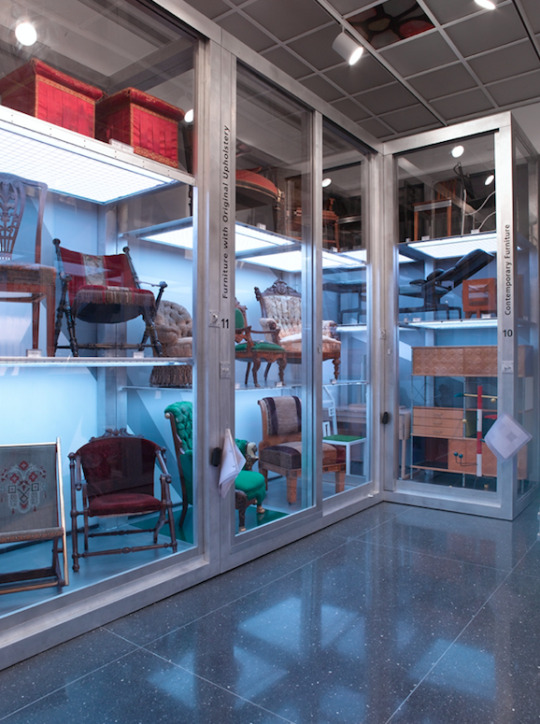
If it seems like the museum has a lot of chairs, it does. The Museum has an exceptional collection of American chairs from the 1700s to today. The form is an excellent way for designers to express themselves with different styles, materials, and forms.

Folding chairs are not a new invention. During the 1860s and 1870s, George Hunzinger, of Brooklyn and Manhattan, manufactured this folding chair that seems to combine function with upholstered comfort.
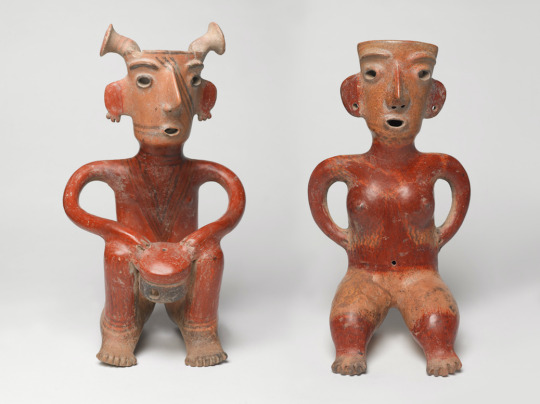
This charming pair of singing Zacatecas ceramic figures from Jalisco, West Mexico may represent a married couple or founders of an ancestral lineage. Placed in tombs to accompany the dead, these animated sculptures reveal aspects of ancient Mexican life over 1,800 years ago. The man’s fashionable antennae-like hairstyle was probably achieved by wrapping hair around an interior support, and the painted designs on their bodies may represent tattooing.
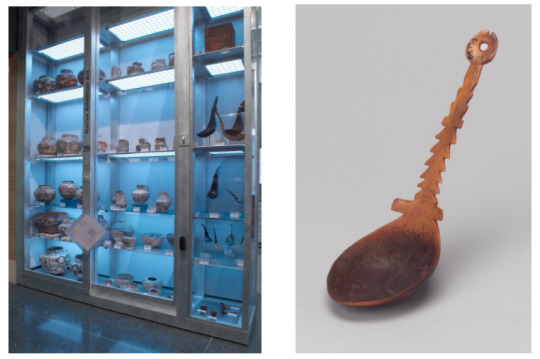
Amid the display of Native American pottery, storage boxes, and eating utensils, this elk-horn spoon dating from the late 19th century was carved and used by Yurok men to eat an acorn-mush cereal. Today, the Yurok are the largest tribe in California with over 5,000 enrolled members.

This polychrome, wooden statue of Saint Joseph dates from the 19th century and reportedly comes from the church in Zia Pueblo in New Mexico, where it was likely displayed on a sanctuary table. The unidentified artist was likely Native American or of Mexican-Hispanic heritage. Present-day New Mexico was the northernmost frontier of the Spanish Colonial Empire, until Mexico gained independence from Spain in 1821. Its remoteness encouraged the development of religious folk images that differed greatly from their European-inspired counterparts such as the Virgin displayed nearby.
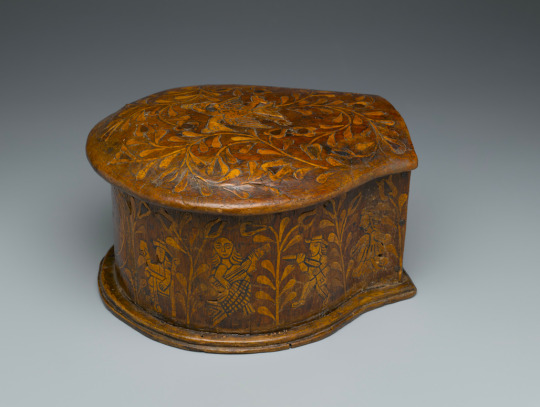
This exquisitely inlaid box from present-day Peru or Bolivia, was likely used to store coca leaves. During the 18th century, such luxury items were prominently displayed in affluent Spanish American homes to underscore the owner’s wealth and social status. Coca-leaf teas were, and continue to be popular as a mild stimulant.
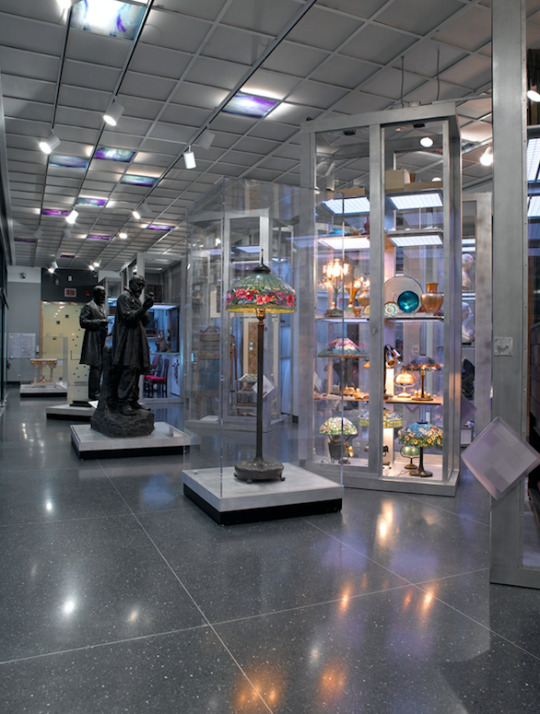
Thank you for joining us on a tour of Luce Visible Storage! Missed one of our other virtual tours? Check them all out here.
Installation Views of Luce Visible Storage (Photo: Jonathan Dorado)
#Brooklyn#Brooklyn Museum#bkmdecarts#bkmamericanart#decorative arts#american art#Art#Artmuseum#museum#Virtual#virtual programming#virtual tours
115 notes
·
View notes
Text
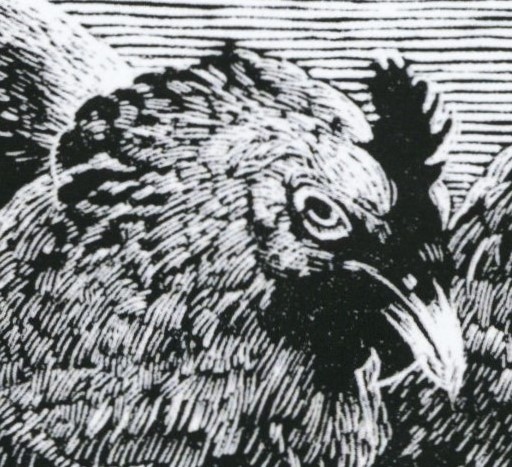
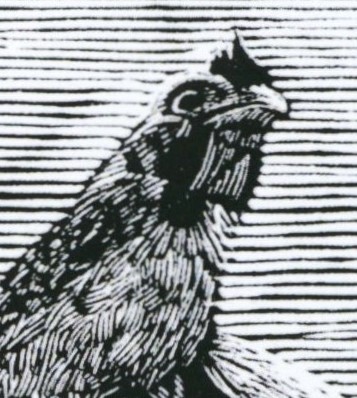


Wood Engraving Wednesday
CHICKENS!!
This 2021 engraving of a chicken threesome is aptly entitled Wary Optimism by Pennsylvania wood engraver and letterpress printer Andrew M. Moroz. Moroz is a member of the national American wood engravers society, the Wood Engravers' Network (WEN). This print appears in the catalog for the WEN Fourth Triennial Exhibition 2020-2022, juried by two of my Wisconsin colleagues, Tracy Honn, retired long-time director of the Silver Buckle Press (Madison), and Jim Moran, recently-retired Master Printer and Collections Officer at the Hamilton Wood Type and Printing Museum (Two Rivers). On wood engraving, Andrew Moroz writes:
Attracted by the liveliness of the marks and the degree of fineness the tools produce, I enjoy the methodical process of engraving with burins on the end-grain of maple. Subject matter draws from personal experience and interests, but is concerned primarily with a search for imagery that has universally held meaning.
Reflecting on jurying this show during the pandemic period, Tracy Honn writes:
I discovered my understanding of the work had changed because the world was reoriented. Thinking about the Wood Engravers Network helped remind me of the extra in the ordinary. . . . The current disruptions of life-as-we-knew-it happened abruptly and nearly simultaneously. It is the all-at-onceness of this crisis that reveals the black and white of our days. In the midst of a pandemic . . . we create places of safety through our imagination and activities of comfort. This is what wood engravers do all the time.
I am excited and deeply honored to serve as the juror for the Fifth Triennial Exhibition of the Wood Engravers' Network, 2022-2024!
View more engravings by members of the Wood Engraver's Network.
View more posts with wood engravings!
View more posts with CHICKENS!!
-- MAX, Head, Special Collections
#Wood Engraving Wednesday#wood engravings#wood engravers#Andrew M. Moroz#Wary Optimism#Wood Engravers' Network#WEN#WEN Fourth Triennial Exhibition#Tracy Honn#Jim Moran#exhibitions#exhibition catalogs#chickens#Chickens!#birds#birbs!
60 notes
·
View notes
Video
Plant Printing by Lester Public Library
Via Flickr:
TR Teen Night, Lester Public Library, Two Rivers, Wisconsin
#365LIBS#Lester Public LIbrary#libraries and librarians#LPL#Library#Lester Public Library#Two Rivers#WIsconsin#Libraries#libs&libs#Hamilton Wood Type & Printing Museum#Printing#Printing Museum#print#teens#teens@LPL#teens in your library#teen#teenprograms#teen late night#Read#Discover#Connect#Enrich#flickr
1 note
·
View note
Text
Victorian undergarments: a guide for Terror fans
AKA the truth about men’s corsets, leather gear, garters, over the knee stockings, drop front versus front fly trousers and More Terror Shit Shirt Posting
My hot mess of a shirt post continues to get notes. I continue to get lovely asks and pms, so I’m going to bring you more shirt information as well as more info about other articles of historic clothing worn in the Terror. My hope is that this will be useful for fic writers and artists as well as giving fans a deep dive into one of my favorite obsessions: historical dress.
The style of shirt that Francis wears was an all purpose undergarment. It was almost always white, or unbleached linen (though cotton was used for shirts at that point in the 19th century). It was cut with a very full sleeve (up to twenty inches) to allow ease of movement and long tails which were tucked under the groin to form a protective layer between the body and trousers. The shirt was not a button down as we know it, but had a pullover V-neck with two buttons at the throat as on this extant example:

One of the things that interesting about this shirt was how little it changed over the years. This cut of shirt had a 150+ year reign. It was a practical design that provided a washable layer next to the body. The generous sleeve allowed for a variety of clothing to be worn with it. It had the downside of requiring a lot of fabric (more than 3 yards of linen for each shirt) and as such patterns could be a complex patchwork of sewn together squares that helped avoid waste.
By the 1840s men’s shirts were changing. The front was often decorated with pintucking, the fabric was lighter weight cotton, rather than linen, but the full sleeves and long tails were still in evidence.
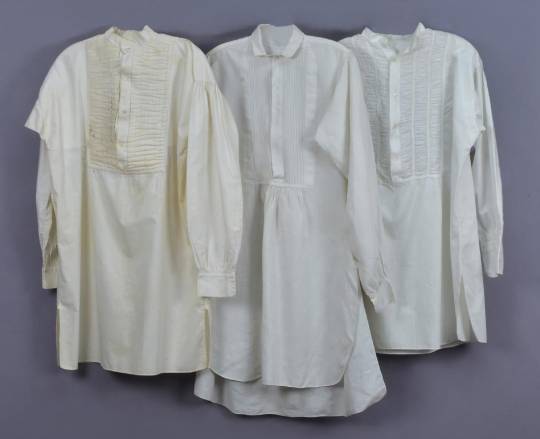
Those would gradually be lost over the next decades as the popularity of knitted drawers, union suits and other types of underwear came into being and as sewing machines made mass production of shirts possible.
But obviously our Francis cares nothing for these modern shirts and wears his old favorite that he has owned forever, possibly made by a family member, as was common in the period especially for officers in the military. Mind you, it doesn’t really matter most of the time that his shirt is very old as it was never meant to be seen. One of the worst costume fantasies that has been perpetrated in so many period films is the gentleman walking around in his shirt. At least Andrew Davies Mr. Darcy had the good sense to be embarrassed to be caught in his shirt. Joe Wright’s Darcy actually goes a courtin half dressed...but I digress. We only see Crozier in his shirt sleeves after they’ve left the ship, have been hauling for a few days and during the mutiny. I like to think that Crozier realizes that wearing his old shirt will help the men identify with him more.
If you were an officer in the military you would be provided with a steward or valet to assist in your dressing. This man would also help to keep your uniform clean and and in good repair. (Honestly one of the best relationships in all of fiction is the one between Captain Jack Aubrey and his steward, Killick, who lives in a state of constant paranoia about Aubrey’s uniforms.) An officer would have several shirts so that they could have a clean one at all times and they would probably keep a best one for dress. (Maybe Francis has a cotton shirt with pintucking, folded away in a trunk somewhere, guarded feverishly by Jopson) The sailors who had no access to regular laundry would have a few as well, though they might be made of cheaper, rougher cloth, with ticking or striped patterns on them, like the one Hickey wears during his trail.

Again, Francis appearing hauling alongside the men in his shirt is his way of signaling to them that he is one of them. Mr. Goodsir, also appears in his shirtsleeves after the mutiny, a sign that his civilized veneer is scraped away along with his outer uniform.
Drops and drawers
Well into the 19th century both men and women had no such thing as drawers, pants, underpants, knickers etc. as a rule. For men, the long shirt tails were tucked under the groin, front and back and created a little, er..nest for their equipage. For women, the shift, just a long shirt really, provided a layer of protection between menstrual blood and valuable gowns and stays, as well as protecting less washable layers from sweat and grime.
But for the men of the Terror, there was layer of knitted wool underwear, that may have been either two pieces or one suit, with buttons running the length of the body. There are very few examples of these garments, but we do know they existed thanks to the Maritime Museum saving Lord Nelson’s stuff.:
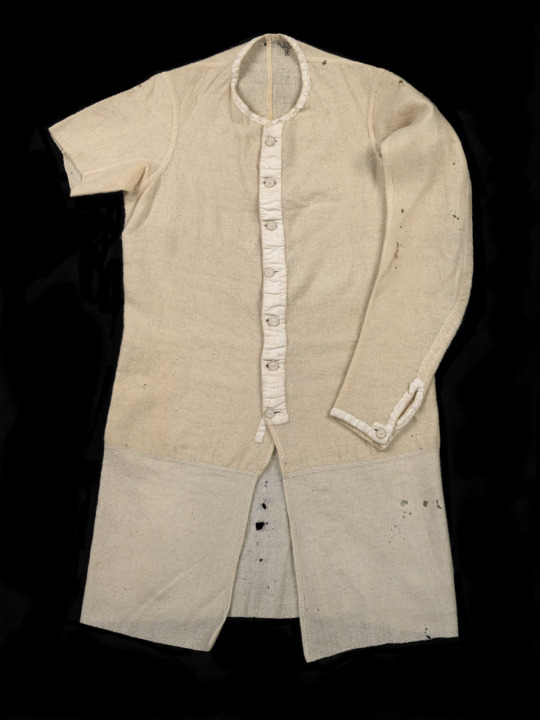
Interesting that this shirt has the long tails for tucking. But by the time of Franklin expedition, knitted long drawers would have been available as well. The full long underwear suit wasn’t patented until the 1860s in America (where it’s use by soldiers in the Civil War earned it the moniker “union suit.”) However that doesn’t mean some kind of full suit of long underwear wasn’t available in England at the time of the expedition. My guess is that Francis has a separate shirt, the top of which is visible during the crisis over Mr. Morfin, and woolen or cotton “drawers” which he mentions to Jopson on the morning after Morfin’s death like these from 1840s made by John Smedley:

Hickey is shown in his underwear after Irving’s murder and then after the mutiny he adopts it as a sort of uniform (complete with stolen boots and great coat) of the new regime. It’s such a wonderful little detail that this BASE creature is wearing only a BASE layer.
Garters, Stockings, Corsets and other Kinkwear from Military history
Men’s and women’s stocking differed very little in the 19th century. Over the knee stockings of embroidered silk would have been kept for dress, but every day socks of cotton and wool with embroidery near the top or “clocking” (because the pattern was often of a clock) were worn by all.
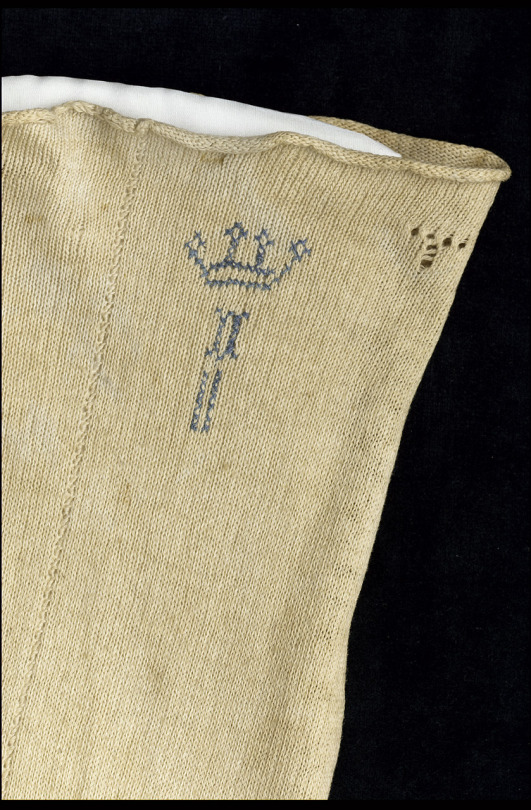
Lord Nelson’s stockings had a crown insignia instead of a clock, which I just think is neat. (His undershirt has the same insignia at the neck...whether it was Emma Hamilton or Lady Nelson doing this embroidery, we’ll leave to Terrence Rattigan to decide...)
Officers would have had dress socks that were held up by sock garters (elastic garters for men and women were patented in the 1820s.) Given that their shirt tails were cut to mid thigh and their socks were over the knee, it’s fairly plausible that they used a double ended garter which clipped at one end to the shirt tail and the other to the top of the stocking. If all of this is sounding like some of the racier James Fitzjames fanart that is not my fault. Blame history!
Speaking of which, did you know that men sometimes wore corsets to make their uniforms fit better? This 1830s Royal Marines uniform at the Maritime Museum is specified to have required a corset for proper fit. Sadly the corset didn’t survive! (If anyone wants to draw Tozier, Pilkington or Hedges in a corset, I would very much like to see that.)
As if all of that weren’t kinky enough, there is this leather and rope jock strap, which was attached to a corset, also from the very naughty nautical museum in slutty, slutty Greenwich. The less said about the white crust on the jock strap the better.
Waistcoat Discourse
Well this will probably be a bit pedestrian after that section, but I think it’s worth talking about waistcoats as well. In the flashback scenes Francis wears a fancy silk waistcoat that has the same cut as the other wool one he wears.
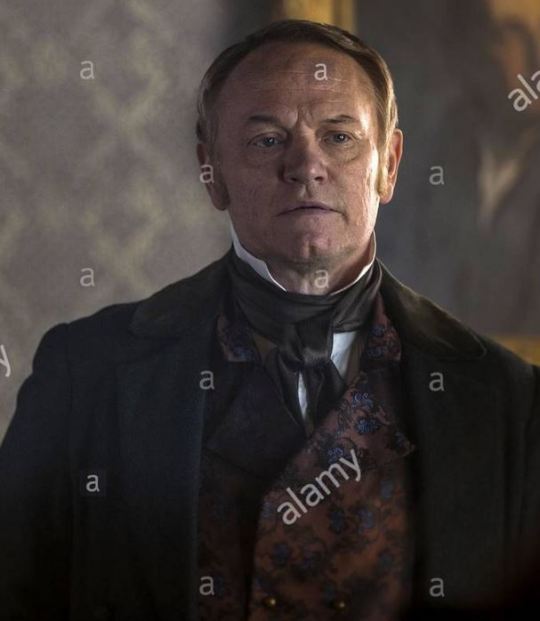
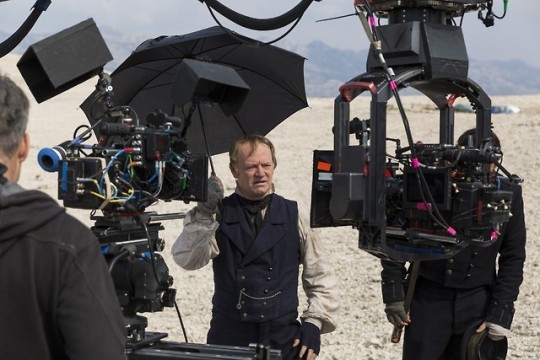
Again this is Francis’ practical nature. Navy uniform patterns were sent out in 1843 with changes to the uniform, including a different waistcoat, so he’s having his man make the waistcoat off the same pattern, saving him money. An interesting footnote was that the Lieutenants uniform in 1843 had a bunch of additional gold braiding and there were many complaints to the admiralty about the cost of these additions. There was also a thriving second hand market in used uniform jackets.
Fitzjames has a white waistcoat cut from the same pattern.
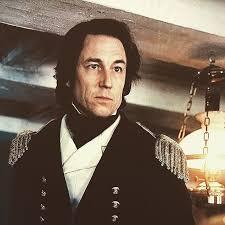
Which is based off of the portrait of real life Fitzjames.

Wool flannel would have been the fabric of choice for arctic explorers. It’s a nice little detail, that The Real Mr. Hickey had a plaid flannel waistcoat in the flashback scene:
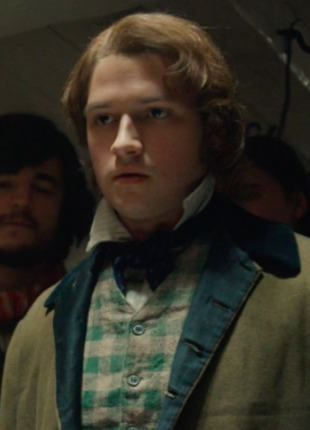
That striped shirt looks familiar! I wonder if the imposter Hickey took his clothes after he dabbed him?!
And finally: STOCKS
In the 18th and 19th centuries men went so far as to cover the collar of the shirt with a stock (think of it as a cumberbund for the neck) so that their collar wasn’t peaking out from their tie. It also helped to make for the appearance of a long, graceful neck. I mean scroll back up and check out the giraffe neck on historical JFJ. Stocks have generally fallen into the vast pit of forgotten fashion and it’s the rare historical costume nerd that even knows what they are, yet for almost 200 years they were considered essential kit for men. Officers in the military HAD to wear a stock as part of their uniform, and it was often uncomfortable (the base of the stock was made of leather, horsehair or WOOD) and covered with fabric. It buckled in the back, requiring a servant to help put it on. Here is a 1845 silk and leather stock from the Maritime Museum:
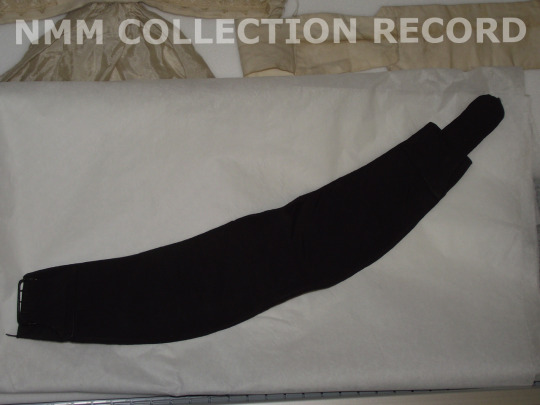
Though it isn’t exactly undergear, trouser fronts were in flux during this period. Here is the 1843 uniform with the fall front trouser opening. But in the world outside the navy, fly front trousers are starting to pop up around 1840ish.You are welcome to my JFJ has newfangled fly front trousers head canon...
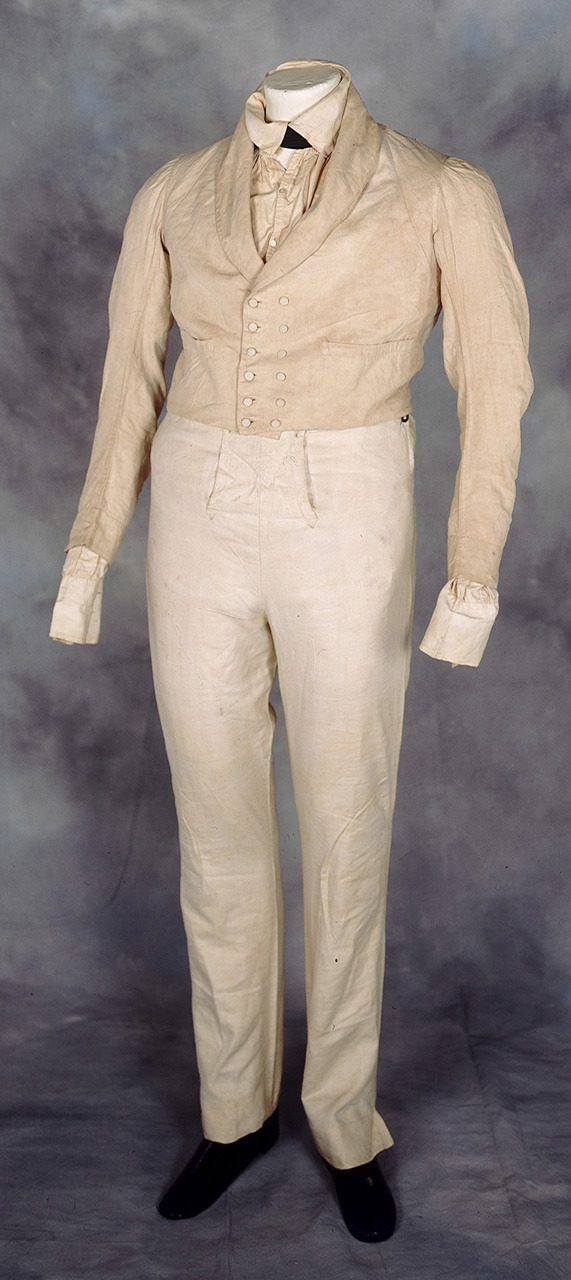
#the terror#fashion history#corsets#leather gear#stockings and garters#waistcoats#stocks#18th century#19th century#Jared Harris#Tobias Menzies#Naval History#Age of Sail#the franklin expedition#Adam Nagatis#Cornelius Hickey
894 notes
·
View notes
Text
The Incredibly Unlucky Church
By: Lisa Timmerman, Executive Director
Many of our narratives and collected oral histories of Dumfries indicate a prosperous “moonshining” industry operating throughout the region. Unfortunately for the 3rd Quantico Church in Dumfries Public Cemetery, this robust activity allegedly fueled a devastating fire.
As the title of this post suggests, the Episcopal Church had a penchant for destruction. People first constructed a Chapel of Ease of Overwharton Parish around 1667, which served as a satellite church to the community. As more people populated the area, it became a Chapel of Hamilton Parish (established from Overwharton) until Dettingen Parish formed (from Hamilton) encompassing most of the PWC area. In 1751, Church officials ordered the construction of “a new brick church, 30 feet by 60 feet” to replace “the old and indifferent church”. William Waite constructed the church and by 1756 it was operational. During the Revolutionary War, soldiers potentially received smallpox inoculations at the church and Baron Ludwig von Closen noted a “very fine Presbyterian church” along the banks of Quantico Creek – possibly the 2nd Quantico Church. By 1813, the 2nd Quantico Church burned down, and the town people may have temporarily used Dumfries Courthouse for their religious services. In 1837, Bishop Meade recorded, “…the old courthouse in this place has been converted into a very comfortable place of worship and is the joint property of Episcopalians and Baptists.” The 3rd Quantico Church was then built in 1878 on the site of the former, “measuring 28 feet by 50 feet” and remained in place until 05/08/1934. Records indicate the interior was paneled with boards measuring 12” to 14” wide, utilizing different native timbers.
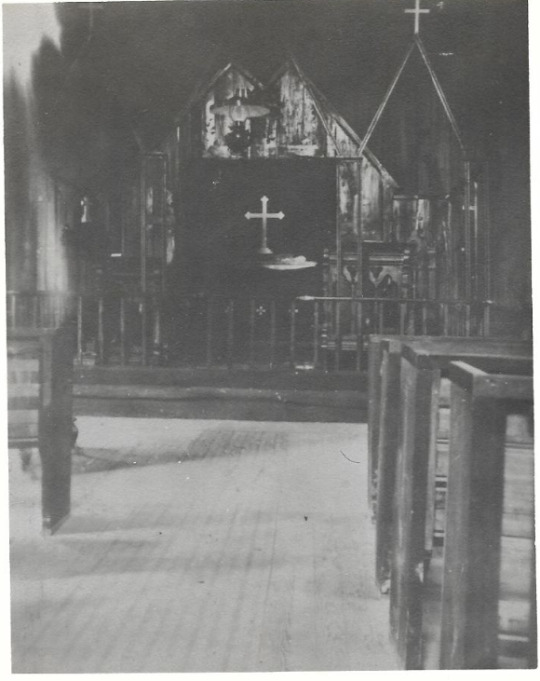
(Source: HDVI Archival Files, Interior of 3rd Quantico Church)
In an interview conducted in 1988, Cecil Garrison indicated the reason for the fire along with the Church’s fate, “The Episcopal Church, they had a nice church out there. During prohibition, a couple of guys went out there. They hadn’t used it for a long time. But, a couple of guys went out and put a still in the vestry room…And the still blowed up and burned the church down…You see, how I knew it, I was cutting grass in my back yard, and I saw the smoke. I arrived there, and when I did, these two guys were running up through the woods. And, I looked in the vestry room; it was all on fire.” “Burned down completely…And, they had some wonderful furniture in there, too…Everything was lost.” In 1998, Lee and Hilda Lansing discussed the fire as well, “The church had stopped being used as a church, and somebody went over there, I think Cecil had something to do with it. But they were making moonshine in the church building.” Hilda: “It was there when I was a kid, but it was burnt. I always heard that they were smoking.”
Moonshine, the illegal process of distilling liquor, has a long history in Virginia. Transportation, remote locations, and taxes were important factors when considering the practice. Prohibition inadvertently led to a booming illegal operation even after the ban on alcohol ended in 1933. The Blue Ridge Institute & Museum identified three different popular stills: the Turnip, the Blackpot Submarine, and the Steam. Mr. Garrison did not identify the type of still he observed. Three bushels of dried corn or seven bushels of apples could distill about two gallons of alcohol and the “slop” leftovers could be fed to livestock. You could judge the strength of the alcohol by the bead of bubbles formed after shaking the product. The flammability of the process is obviously a problem, but the actual finished product can contain toxins depending upon the type/materials of the still used. The expression “lead burns red and makes you dead” stems from the practice of lighting a sample of the product on fire with a blue flame indicating it was lead free – certainly not a reliable test for safety. Unregulated moonshine can also be too potent and toxic, leading to alcohol poisoning, among other health hazards.
Today you can visit Dumfries Public Cemetery and see a marker near the remains of the church. Whether the fire resulted from moonshine or something else in the 1930s, the three Quantico Churches experienced incredible times in American history – from the Revolutionary War to Prohibition, these buildings survived war, rebellions, but apparently not unaged whiskey.
Note: We have a fundraiser ongoing for our Halloween programs! The Maskatorium is offering two different facial coverings with either the Weems-Botts or Dumfries logo. Click here for the order form and here for the PayPal link.

(Sources: HDVI Archival Records: Hoagland, Ann. Transcript (Draft) of Interview with Cecil Garrison. Prince William County Historical Commission Oral History Project, 02/1988. Note on draft: Due to editing for clarification purposes, this document cannot be classified as a true verbatim transcription of the conversation with the aforementioned persons; Jackson Arvilla and Sue Taylor. Oral History Transcript with Hilda and Lee Lansing, 10/08/1998; Sipe, Boyd. Cemetery Delineation and Phase I Archaeological Investigations of the 11.3 Acre Dumfries Elementary School Property, PWC. October 2009; The Blue Ridge Institute and Museum of Ferrum College: Moonshine – Blue Ridge Style, The History and Culture of Untaxed Liquor in the Mountains of Virginia (online exhibit); Prince William County: A Past to Preserve. The Prince William Historical Commission)
#localhistory#museumfromhome#archives#oralhistory#folklore#moonshine#fire#churchhistory#cemetery#revolutionarywar#destinationdumfries
1 note
·
View note
Photo

The key to all the quoins. Have you seen this marvel, @blferrett ? As seen at @hamiltonwoodtype (at Hamilton Wood Type & Printing Museum) https://www.instagram.com/p/CeuJQN3OKzt/?igshid=NGJjMDIxMWI=
4 notes
·
View notes
Text
Goma Glasgow
Glasgow has lots of interesting places to learn about art and design like museums, landmarks and buildings.
A building I went to was the gallery of modern art (GOMA) built in 1996 and designed by William Cunninghame it ranged from exhibitions and paintings to sculptures and model work. I enjoyed my tine there and was very good to see other arts in person instead of pictures on google and the internet.
My favourite exhibit I seen was Disorient by Fiona tan, it was very interesting as it was interactive as well as informative, the work/exhibition makes it return as it was first and last introduced in 2012 when it was placed in the same place it is today.
Another exhibit was Mark Making: Perspectives of drawing which is by six young artists : Erica Eyres, France-Lise McGurn, Gregor Wright, Johnathan Owen, Lois green and Ross Hamilton Frew. The exhibit took up 3 rooms within the gallery.

The lighthouse
From 1999 to 2009 the lighthouse was owned by “The Lighthouse trust” but has since been owned by Glasgow city council. Designed by Charles Rennie Mckintosh the lighthouse was built in 1895 and has since been the centre for design and architecture in Glasgow. The building features exhibitions such as – Material Considerations which was my personal favourite which gives everyone from primary age to architects a chance to see different and a wide range of materials commonly used in buildings/estates
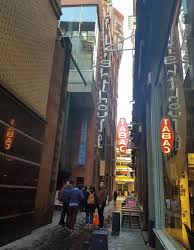
Kelvingrove Art Gallery
Designed by John William Simpson and Edmund John miller Allen Opened in 1901 and built backwards to front, the Gallery remains one of Glasgow and Scotland’s most popular and well known landmarks. Filled with architecture and art from different artist from around Britain and Europe. It includes 22 galleries with exhibits from the renaissance to authentic artefacts from ancient Egypt every day an organ recital takes places which can be heard throughout the gallery. The building was closed for 3 years for refurbishment and cost around £28 Million
Riverside museum
The Glasgow riverside museum and tall ship that features 3000 different art pieces, from cars and busses to a train. Designed by Zaha Hadid opened in 2011 and won the 2013 Museum of the year award and the building cost £74 million. My favourite exhibit is the street, which includes shops/cars and buildings from years ago and showed what they would have looked and sounded like inside. They show what type of things you find inside which is interesting to me.

Finch and Fouracre
Finch and fouracre is a design/model making company in Glasgow, they make small to large models of many things like architectural models and distillery units. Founded in 2008 by Franki finch and Beth fouracre, they promise no model will be the same and no model is “production line” job and every job has 100% effort in all pieces. Franki finch graduated from Glasgow school of art with product design and studied for a semester in Stuttgart. They use materials from wood to plastic to model board and create brilliant models for companies, engineer’s architects and private clients, or anyone who wants one.
Flux Laser Studio
Founded by Alice Jacobs 7 years ago and started out herself and her friend with the laser machines in the room they are still in now. They have 3 large CNC laser cutters and offer numerous services and can work with endless amounts of materials including leather, metal and plastic.
The company are moving to a new and bigger strudio to work out of soon. The services cost £33 an hour but £24 an hour to students. They have worked with Glasgow school of art and Glasgow sculpture studios.
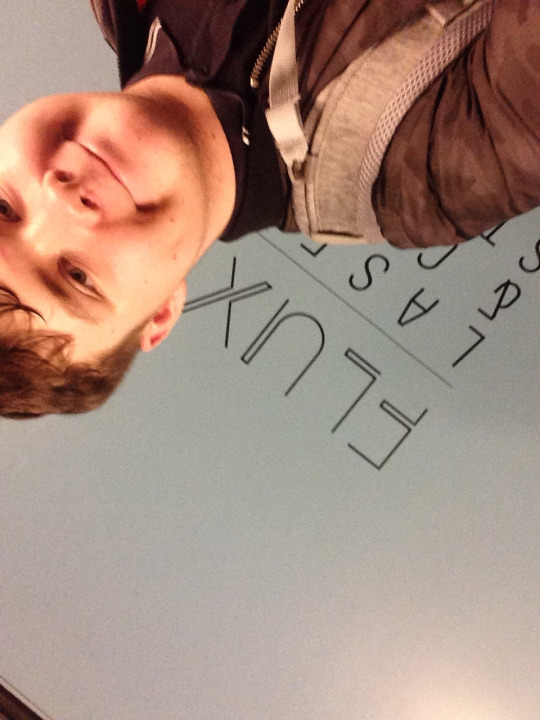
1 note
·
View note